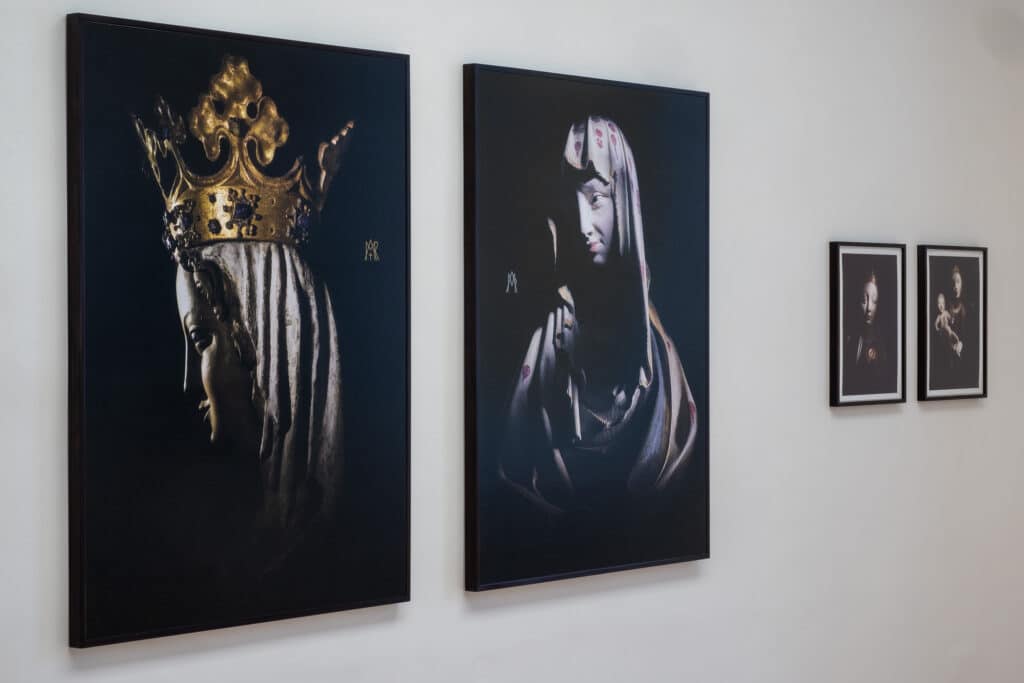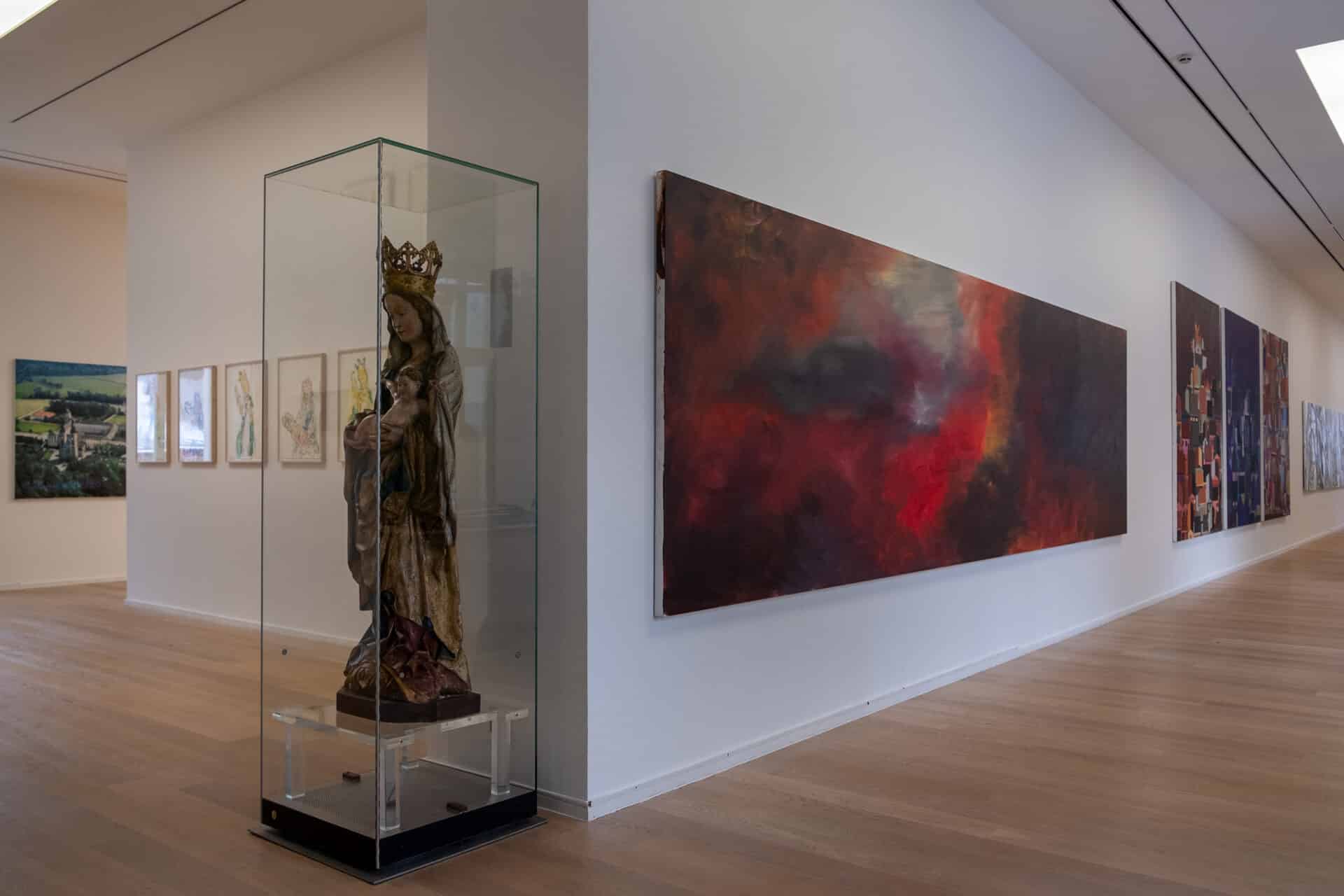Aspects of the Contemporary Art Collection
This special exhibition offers representative insights into the most recent collection of Admont Abbey. It is dedicated to contemporary art and has been under construction since 1997. It currently consists of over 1000 works by around 180 Austrian artists, most of whom were born in the second half of the 20th century.
Since its opening in 2003, the museum of Admont Abbey has been known for its emphasis on the dialogue between old and contemporary art. The various museum departments also communicate with each other. Representing this dialogue, upon entering the contemporary art section, visitors are greeted by a Gothic Madonna: the Madonna with Child from the circle of Jakob Kaschauer. The reason for this surprise becomes apparent in the final room of the exhibition – please continue reading!
The first part of the exhibition is dedicated to Austrian painting from the 1980s onwards, which has its roots in the "New Painting" and "New Abstraction" movements and has evolved in various directions. These works, including those by Siegfried Anzinger, Erwin Bohatsch, Herbert Brandl, Gunter Damisch, Alfred Klinkan, Alois Mosbacher, Hubert Scheibl, Hubert Schmalix, Walter Vopava, Erwin Wurm, and Otto Zitko, constitute an important foundation of the Admont Collection of Contemporary Art.
The second room ties in seamlessly with the theme of "Life, Death, Resurrection" from the anniversary exhibition, which can be seen one floor below. The central work is a symbol of baroque joie de vivre: Götz Bury's seemingly sumptuous "Gala Dinner", consisting purely of trash pieces.
Surrounding this, there are artworks that explore themes of transience and the question of what awaits us after death. Here, you encounter three works from the MADE FOR ADMONT series, which hold particular significance for the Admont Collection and this exhibition. Among them is a painting from the recently created series by Nikola Irmer. It subtly renders taxidermied animals from the Admont Natural History Museum into the painterly medium. Additionally, there is a large-scale transformation of Josef Stammel's sculpture "Der Tod" (Death) from the Admont Abbey Library into the contemporary visual realm by Michael Horsky. And a photographic work composed to resemble an old painting from the "Admont" series by Lois Renner, in which, among other works from the Art History Museum, a "Stammel cross" has been integrated. The original Baroque cross by the Abbey sculptor Josef Stammel hangs directly beside it.


Surprising interpretations of the cross motif can be found in Christian Eisenberger's flambéed sugar cross and Manfred Erjautz's Lego cross. Christoph Lingg takes up the theme of environmental destruction in his photographs. Adding a touch of humor is the taxidermy of a sheep by Deborah Sengl, wearing a sweater knitted from its own wool.
The "MADE FOR ADMONT" programme was launched in 2000 with the first "Artist in Residence", Lois Renner. Hundreds of MADE FOR ADMONT works by over 70 artists are now represented in the collection. They are the results of specific localisation processes relating to the region, Admont Abbey, the museum and its contents. The medium of photography plays a central role.
The third exhibition area is dedicated to an important representative of this commissioned art genre: the multimedia work of art "Zeitperlen" (2005-2012) by Johannes Deutsch. The range of works you can experience here includes a Paradise Triptych, a multimedia opera and music experience featuring the Vienna Philharmonic, storyboard tableaus, and a musical score. All works are based on an examination of the baroque splendour of the Admont Benedictine monk Fr. Benno Haan.
The fourth room is dedicated to seeing, not seeing, and apparent seeing. A video by Barbara Eisner-B. and works by Adi Brunner, Julie Hayward, and Maria Hahnenkamp introduce you to the worldwide specialty of the MADE FOR ADMONT exhibition: the special collection "JENSEITS DES SEHENS - Kunst verbindet Blinde und Sehende" (BEYOND SEEING - Art connects the blind and the sighted). These artworks, created for the Admont collection since 2002, do not center around visual perception. They are crafted with the highest quality standards for visually impaired, blind, and sighted individuals, fostering a dialogue.
Brigitte Kowanz confronts us with a text translated into light morse code. Heidrun Widmoser and Eva Schlegel blur reality. Tobias Pils paints in monochrome. Ruth Schnell generates words disassembled into light points with LED rods. Klaus Dieter Zimmer leaves the question open as to whether we see an image or a sculpture. Uwe Bressnik's seemingly painted Saint Benedict turns out to be a subtle creation made up of small crosses, ground from a small sculpture of the saint reduced to metal dust. Judith Huemer's photo appears colorful and cheerful but, upon closer inspection, conceals a serious theme. Dieter Huber puts forth a painterly assertion and presents the abbey in a way that it truly is not. One mustn't believe everything one sees, everything one reads!
The last exhibition area leads us back to the Gothic Kaschauer Madonna. She not only watches over the entire exhibition. Above all, it is the central theme of this area, which is dedicated to medieval Madonnas. From the French artist Guillaume Bruère, we see quickly thrown variations of the Admont Madonna and the Admont Vesperbild. Bruère works quickly and creates many works in a very short time with energetic, vibrant strokes. He draws in museum collections. He created both motifs originally located in Stift Admont in front of the originals housed there, in the Alte Galerie at the State Museum Joanneum in Graz.
The South Tyrolean artist Peter Unterthurner engages with sacred sculptures from the Middle Ages in his "Alpenmadonnen" (Alpine Madonna), a series that explores a time when life was challenging and faith ran deep. The photographic selection from this series partly intersects with Bruère's motifs. The original Kaschauer Madonna appears alongside contemporary artistic interpretations. Moreover, Unterthurner transforms the "Alpenmadonnen" motifs into a multimedia dimension.
In a special room, the different paths of development of two artists who were important for the Styrian art scene in the post-war period become tangible: Hannes Schwarz (1926-2014) and Gustav Zankl (*1929).
Additional works from the contemporary art collection are integrated into the context of other museum areas.
With works by: Siegfried Anzinger, Erwin Bohatsch, Herbert Brandl, Guillaume Bruère, Adi Brunner, Hannelore Demel-Lerchster, Gunter Damisch, Johannes Deutsch, Christian Eisenberger, Manfred Erjautz, Bruno Gironcoli, Maria Hahnenkamp, Julie Hayward, Michael Horsky, Dieter Huber, Lisa Huber, Judith Huemer, Nikola Irmer, Jakob Kaschauer, Alfred Klinkan, Sebastian Köpcke, Brigitte Kowanz, Christoph Lingg, Rudi Molacek, Alois Mosbacher, Tobias Pils, Lois Renner, Arnulf Rainer, Hubert Scheibl, Eva Schlegel, Hubert Schmalix, Ruth Schnell, Hannes Schwarz, Deborah Sengl, Josef Stammel, Norbert Trummer, Peter Unterthurner, Walter Vopava, Volker Weinhold, Franz West, Heidrun Widmoser, Erwin Wurm, Gustav Zankl, Klaus-Dieter Zimmer, Otto Zitko






















